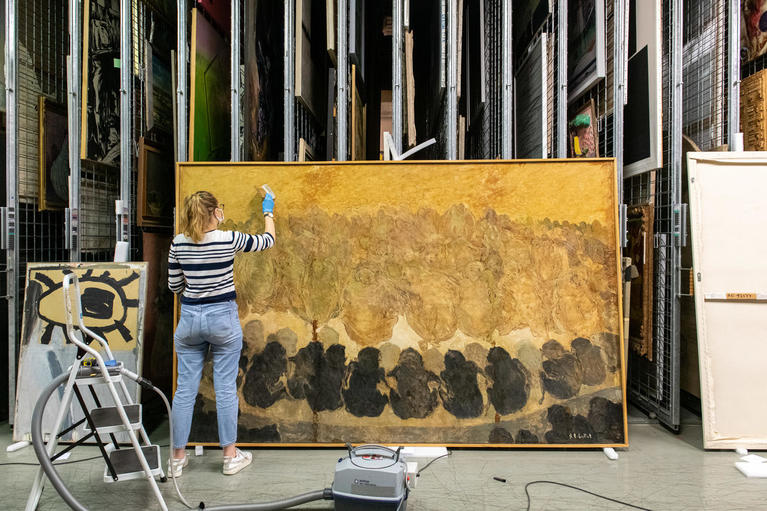CNAP begins a formal survey of its collection

Roger Edgar GILLET, Le narcissisme de groupe, 1974, Oil on Paper on Canvas, 190 x 300 cm (Inv. : FNAC 35164)
For several months now, the Centre national des arts plastiques (CNAP) has been engaged in a project never previously undertaken: a complete survey of its collection.
In an unprecedented operation, over a period of three years no fewer than 37,000 works in deep storage at the La Défense site, west of Paris, will be examined ahead of relocation in 2024 to Pantin, in the greater Paris area. The survey will prepare the works in France’s national collection - which is managed by CNAP - for transfer and installation in the 25,000 square metres of new storage space in Pantin.
For the purpose of the survey, CNAP has enlisted a team of some twenty specialists who work in close consultation with its own staff in conservation, management, documentation and communication. They have three years in which to review the 37,000 objects in the collection and bring this ambitious project to a successful conclusion… on time!
The benefits of a collections survey
This survey is an opportunity for CNAP’s scientific teams to inspect the condition of the works in the collection and make improvements to how they are cared for and conserved. It is also a chance to examine and rediscover each work in turn. Lastly, it is a means to physically apprehend the complexity and scope of the collection, and from there inform more widely on its history and make the works available for view.
This objective which CNAP has set itself prior to relocation to Pantin lays the groundwork for the future of the collection. It will enable staff to plan conservation and restoration for the years ahead, beyond the duration of the survey itself, based on priorities agreed by CNAP staff and teams working on the project. It will also enable CNAP to expand its mission of short and long loans to cultural bodies, in particular as part of future partnerships in France and internationally.
The survey is carried out using a systematic approach in stages. These stages form what is known as a processing chain. A work taken out of storage has its identity checked then compared with information in the database. Depositions of dust are cleaned, a condition report is filed and recommendations for conservation are made (these can be more or less long-term). Conservation and restoration work is carried out and recorded in the database, the work is photographed, protectively wrapped then packed, ready to be moved.
The collection survey will enable CNAP to:
- locate and identify works;
- record the latest condition of the works and enable necessary conservation-restoration to be carried out;
- photograph the works;
- protect and pack the works prior to transportation.
A team of multiple specialisations
In order to bring this three-year project to a successful conclusion, CNAP has appointed three teams of specialists with complementary skills. One team is in charge of handling and packing the works for transportation. A second team is in charge of the processing chain and a third is responsible for high-definition photography. All these teams are made up of qualified professionals, each contributing his or her competencies and expertise: specialists in preventive conservation, research assistants, conservation technicians, restorers, registrars, photographers, packers and movers. A coordinator oversees the coherency of operations and monitors deadlines.
Throughout the entire duration of the survey, CNAP opens its doors to some twenty people who, each day, work in the deep storage facility in close collaboration with permanent staff. CNAP teams monitor the processing chain while continuing in their regular roles (conservation, acquisitions and presentations of the collection, support mechanisms for the visual arts sector).
All the items in the La Défense deep storage facility - graphic arts, objects/sculptures, photographs, paintings and textiles - are given equal attention. In addition to documenting the works, photographs can be used to enrich the online database as well as print publications.
Provisional schedule
The collection survey was put on hold for several months due to the coronavirus pandemic, causing disruptions to the schedule. Works are surveyed per typology in the following order:
- Until October 2020: more than 21,000 graphic artworks.
- November 2020-February 2021: 1,580 objects and sculptures.
- March-April 2021: more than 300 textile items.
- May-July 2021: 2,100 paintings.
- September 2021-May 2022: approximately 13,000 photographs.
- Summer 2022: packing of works for transfer from La Défense deep storage to the new facility in Pantin.
Want to keep track of progress?
Go behind the scenes and follow each stage in the collection survey thanks to CNAP social media. #chantiercollectionscnap